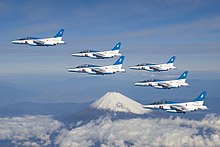Blue Impulse
This article includes a list of general references, but it lacks sufficient corresponding inline citations. (March 2011) |
| Blue Impulse 11 Squadron 4th Air Wing | ||
|---|---|---|
Trainer 9 Kawasaki T-4s | | |
Blue Impulse (ブルーインパルス, Burū Inparusu) (currently 11 Squadron 4th Air Wing, previously 21 Squadron 4th Air Wing) is the
History
The first unofficial Japanese aerobatic team was formed in 1958 at
In 1959 the
The first demonstration of the "Tenryū" team, (named after the Tenryū River near the air base), was on 4 March 1960 at Hamamatsu, the name was found to be hard to pronounce in western languages, so the team was renamed Blue Impulse. The aircraft were equipped with smoke generators using five different colours for each aircraft: white, red, blue, green and yellow and painted in silver, light blue, blue and pink; on the leader's aircraft, the blue is replaced by gold. Later, in 1961, all five aircraft received a special paint scheme of overall white with blue flashes.
In 1964, Blue Impulse performed at the opening of the 1964 Summer Olympics in Tokyo, drawing the Olympic rings in the air with coloured smoke. In 1970, at the opening of Expo '70 in Osaka, the team drew "Expo '70" in the air.
In February 1982, after 545 air demonstrations, Blue Impulse replaced the Sabres with Mitsubishi T-2 trainers, performing their first show with the new aircraft was on 25 June 1982 at the team's new Matsushima airbase.
At Expo '90 in Osaka, Blue Impulse performed at the opening event and drew the "Expo '90" logo in the air.
The team's last performance with the Mitsubishi T-2 was in December 1995, after 175 demonstrations with these aircraft. The new Blue Impulse aircraft became the Japanese-built Kawasaki T-4 trainer, and the first show with these aircraft was on 5 April 1996.
In 1997, the team made their first foreign debut at the
In 1998 Blue Impulse performed at the Winter Olympics in Nagano, Japan.
Blue Impulse also performed at the 2002 FIFA World Cup; on 4 June 2002, they performed at the opening of the Japan versus Belgium match.
On March 11, 2011, Matsushima Air Base, where Blue Impulse had been based, sustained heavy damage from the Tohoku earthquake and tsunami. Because on the day before, the aircraft and crew had travelled to
On March 30, 2013, the Blue Impulse fully returned to Matsushima Air Base following the completion of repairs and anti-tsunami measures.
Aircraft


| Aircraft | Origin | In Service[a] | Service[b] | reference column |
|---|---|---|---|---|
North American F-86F Sabre |
United States | 34 | 1960–1981 | JASDF Technical Research Section. 5 aircraft formation. |
| Mitsubishi T-2 | Japan | 11 | 1982–1995 | 4 AW 21 Sq. Technical Research Section. 6 aircraft formation. |
| Kawasaki T-4 | Japan | 11 | 1995–present | 4 AW 11 Sq. 6 aircraft formation. |
Accidents and incidents
Data from:[1]
- 21 July 1961
- F-86F-40 Sabre, 02–7976, crashed during aerobatic training into the sea, near Cape Irago, Tahara, Aichi. The pilot, Major Katou Matsuo, was killed.
- 24 November 1965
- F-86F-40 Sabre, 02–7975, aerodynamically stalled and crashed near the west end of the runway at Matsushima Air Base during aerobatic training. First Lieutenant Joumaru was killed in the crash.
- 4 November 1972
- F-86F-40 Sabre, 72–7773, crashed at or near the Iruma River, whilst returning to base after a demonstration flight. First Lieutenant Kaneko ejected safely at 210 m (700 ft).
- 14 November 1982
- T-2B Blue Impulse #4, 19–5174, crashed during a down-ward bomb-burst manoeuvre at a Hamamatsu air display, having failed to pull up in time and crashed into a residential building near the airfield. The pilot was killed, as were 10 people on the ground, with another 13 injuries, as well as damaging 28 civilian houses and about 290 cars. This accident brought performances a halt for the remainder of the year.[2]
- 4 July 1991
- Over the Pacific Ocean, T-2A, 59-5112 and T-2B,19-5172, (#2 and #4), collided during a training flight after flying into sea fog near Mount Kinka, Miyagi Prefecture, causing suspension of demonstration flights for a year. Captain Hamaguchi Seiji and Captain Shikichi Yutaka were both killed.
- 4 July 2000
- Aircraft #5 and #6 collided about 25 km (16 mi) East of Matsushima Air Base, claiming the lives of three team members.
- 20 March 2002
- A T-4 suffered a bird strike.
- 14 October 2006
- T-4 #5 suffered a bird strike at Gifu ABduring training for an airshow but landed safely.
- 29 January 2014
- Two Blue Impulse T-4s collided during a four-ship practice flight 72 km (45 mi) from Matsushima Air Base, both aircraft landed safely with no injuries. The Leader's aircraft (#1) had nose damage, while the other involved aircraft, #2, lost half of its left horizontal stabiliser.[3]
References
Footnotes
Notes
- ^ "BLUE Impulse Losses & EJECTEES". Archived from the original on 20 August 2016. Retrieved 27 August 2016.
- ^ "Japan Investigates Fatal Air-Show Accident". Reading Eagle. United Press International. November 15, 1982. Retrieved May 26, 2021.
- ^ "Losses and Ejections 2014". Archived from the original on 2017-06-22. Retrieved 8 August 2017.
External links
- Japan Air Self-Defense Force - Blue Impulse Official Site (in Japanese)
- Blue Impulse Museum (in Japanese)
- Blue Impulse Fan Site (in Japanese)

